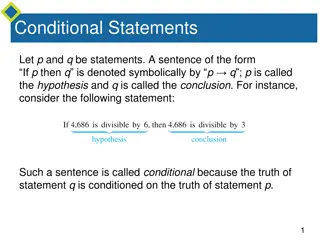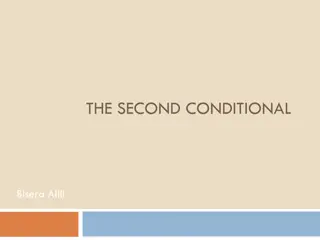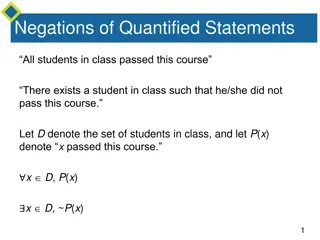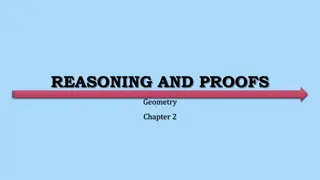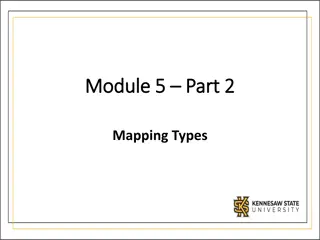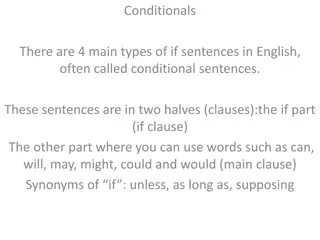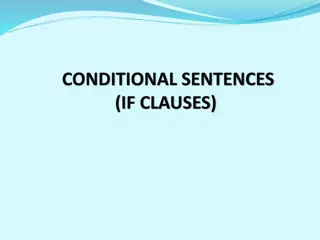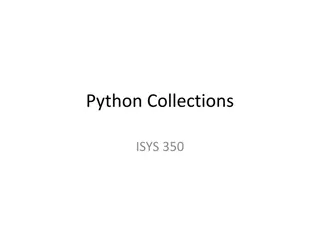Genome Sciences 373: Informatics Quiz, Python Dictionaries, and Conditional Statements Overview
Today's session covers topics such as Python dictionaries with in-class examples, iterating through dictionary entries, counting repeating characters in a string, and understanding if/elif/else statements. The session also includes a discussion on combining tests in Python and comparisons operators. Join the genome informatics quiz section on April 14, 2015, for lectures and assignments on genome sciences.
Download Presentation

Please find below an Image/Link to download the presentation.
The content on the website is provided AS IS for your information and personal use only. It may not be sold, licensed, or shared on other websites without obtaining consent from the author. Download presentation by click this link. If you encounter any issues during the download, it is possible that the publisher has removed the file from their server.
E N D
Presentation Transcript
Genome Sciences 373 Genome Informatics Quiz Section 3 April 14, 2015
Reminder: Office hours Monday 2-3pm Foege S-110
Topics for today Questions from lecture Homework 2 due tomorrow 5pm Homework 3 assigned tomorrow Python overview: dictionaries, loops
Python dictionaries: in-class example How can I count the repeating characters in a string? my_dictionary = { } my_string = ACGATA for my_base in my_string: if else
Python dictionaries: in-class example How can I count the repeating characters in a string? my_dictionary = { } my_string = ACGATA for my_base in my_string: if else
Python dictionaries: in-class example How can I iterate through all entries in a dictionary? # print out only the characters there more than once for my_key, my_value in my_dictionary.items(): if my_value > 1: print saw key %s more than once % my_key # an alternative way for my_key in my_dictionary.keys(): if my_dictionary[my_key] > 1: print saw key %s more than once % my_key
Python if/elif/else: are these different? if (<test evaluates to true>): <execute this> <block of code> elif (<different test evaluates to true>): <execute that> <block of code> VS if (<test evaluates to true>): <execute this> <block of code> if (<different test evaluates to true>): <execute that> <block of code>
Python if/elif/else: combining tests # assign some numbers for testing x=1 y=2 z=3 # test if two statements are BOTH true if (z > x) and (z!=y): <do something> # test if one or both statements is/are true if (x*x + y == z) or (y<=z): <do something>
Python comparison operators both conditions are true either or both conditions are true negation and or not X in Y X not in Y < > == != <= >= is X substring/sublist of Y? negation of above is less than is greater than is equal to is NOT equal to is less than or equal to is greater than or equal to
Python if/elif/else if (<test evaluates to true>): <execute this> <block of code> <The program continues with> <this block of code>
Python if/elif/else if (<test evaluates to true>): <execute this> <block of code> elif (<different test evaluates to true>): <execute this different> <block of code> <The program continues with> <this block of code>
Python if/elif/else if (<test evaluates to true>): <execute this> <block of code> elif (<different test evaluates to true>): <execute this different> <block of code> elif (<third test evaluates to true>): <execute this third> <block of code> <The program continues with> <this block of code>
Python if/elif/else if (<test evaluates to true>): <execute this> <block of code> elif (<different test evaluates to true>): <execute this different> <block of code> elif (<third test evaluates to true>): <execute this third> <block of code> else: <all tests failed, so execute this> <block of code>
Python if/elif/else: combining tests # assign some numbers for testing x=1 y=2 z=3 # test if two statements are BOTH true if (z > x) and (z!=y): <do something> # test if one or both statements is/are true if (x*x + y == z) or (y<=z): <do something> Evaluation goes from left to right following rules of precedence Math > [In]Equality > and/or/not Use () to group things for ease of reading/debugging
Python loops: for loops For loops allow you to perform an operation on each element in a list (or character in a string) for <element> in <object>: <execute this> <block of code> <The program continues> #loop ended <with this block of code>
Python loops: for loops on strings For loops allow you to perform an operation on each element in a list (or character in a string) for <element> in <object>: <execute this> <block of code> <The program continues> #loop ended <with this block of code> Total_A=0 for my_character in ACTTG : if my_character == A : Total_A = Total_A + 1 # now my loop is done print I saw %d A s in my string % Total_A
Python loops: for loops on strings For loops allow you to perform an operation on each element in a list (or character in a string) for <element> in <object>: <execute this> <block of code> <The program continues> #loop ended <with this block of code> Total_A=0 for my_character in ACTTG : if my_character == A : Total_A = Total_A + 1 Each time through the loop, the value of my_character gets automatically updated # now my loop is done print I saw %d A s in my string % Total_A
Python for loops: getting out of the loop Example code: for my_character in ACGAT : <execute this> <The program continues> #loop ended At the end, all characters will have been visited. What if I want to stop if I see a G? for my_character in ACGAT : if my_character == G : break <The program continues> #loop ended
Python for loops: skipping in a loop Example code: for my_character in ACGAT : <execute this> <The program continues> #loop ended At the end, all characters will have been visited. What if I want to skip all G s? for my_character in ACGAT : if my_character == G : continue <do something to all non-G characters> <The program continues> #loop ended continue means: keep going with the loop, just skip *this* particular element. break means: stop the loop.
Python for loops: looping on a list Example code: >>> for animal in ['cat','human','spider']: ... print animal ... cat human spider >>>
Python for loops: looping on a list Example code: >>> for animal in ['cat','human','spider']: ... print animal ... cat human spider >>> Iteration 1
Python for loops: looping on a list Example code: >>> for animal in ['cat','human','spider']: ... print animal ... cat human spider >>> Iteration 2
Python for loops: looping on a list Example code: >>> for animal in ['cat','human','spider']: ... print animal ... cat human spider >>> Iteration 3 and finished
Python for loops: handle a matrix >>> matrix = [[12, 25], [0.3, 2.1], [-3, -1.8]] >>> for my_row in range(0, 3): # [0,1,2] ... print 'row=', my_row ... for my_column in range(0, 2): # [0,1] ... print matrix[row][column] ...
Python for loops: handle a matrix >>> matrix = [[12, 25], [0.3, 2.1], [-3, -1.8]] >>> for my_row in range(0, 3): # [0,1,2] ... print 'row=', my_row ... for my_column in range(0, 2): # [0,1] ... print matrix[row][column] ... row= 0 12 25 row= 1 0.3 2.1 row= 2 -3 -1.8
Python for loops: handle a matrix >>> matrix = [[12, 25], [0.3, 2.1], [-3, -1.8]] >>> for my_row in range(0, 3): # [0,1,2] ... print 'row=', my_row ... for my_column in range(0, 2): # [0,1] ... print matrix[row][column] ... row= 0 12 25 row= 1 0.3 2.1 row= 2 -3 -1.8
Python for loops: handle a matrix >>> matrix = [[12, 25], [0.3, 2.1], [-3, -1.8]] >>> for my_row in range(0, 3): # [0,1,2] ... print 'row=', my_row ... for my_column in range(0, 2): # [0,1] ... print matrix[row][column] ... row= 0 12 25 row= 1 0.3 2.1 row= 2 -3 -1.8
Python for loops: handle a matrix >>> matrix = [[12, 25], [0.3, 2.1], [-3, -1.8]] >>> for my_row in range(0, 3): # [0,1,2] ... print 'row=', my_row ... for my_column in range(0, 2): # [0,1] ... print matrix[row][column] ... row= 0 12 25 row= 1 0.3 2.1 row= 2 -3 -1.8
Python for loops: handle a matrix >>> matrix = [[12, 25], [0.3, 2.1], [-3, -1.8]] >>> for my_row in range(0, 3): # [0,1,2] ... print 'row=', my_row ... for my_column in range(0, 2): # [0,1] ... print matrix[row][column] ... row= 0 12 25 row= 1 0.3 2.1 row= 2 -3 -1.8
Python while loops Example code: i = 0 while i < 5: print i is still less than 5! i += 1 <The program continues> #loop ended Note that I did not have to explicitly exit the loop.
Python while loops Example code: my_gene_file = open( my_genes.txt , r ) total = 0 startsWithA = 0 while total < 100: total = total + 1 line = my_gene_file.readline() if line.startswith( A ): startsWithA = startsWithA + 1 print I have %d of 100 genes starting with A % startsWithA <The program continues> #loop ended
Python while loops Example code: my_gene_file = open( my_genes.txt , r ) total = 0 startsWithA = 0 while total < 100: total = total + 1 line = my_gene_file.readline() if line.startswith( A ): startsWithA = startsWithA + 1 if startsWithA >=10: print Breaking out of the loop! break I can break out of while loops too! print I have %d of 100 genes starting with A % startsWithA <The program continues> #loop ended
Python while loops vs for loops: summary for loops visit every element in a collection (list, string, etc) they exit automatically skip with continue , break out with break while loops keep going forever until the test is false make sure your loop will eventually end before you run! break out with break
How to make a sequential list of numbers Common problem: You want a list of numbers from a to b start: first number (inclusive) stop: last number (exclusive) step: how big is the jump? Solution: range() range(start, stop, step) Example: >>> range(4, 10, 1) [4, 5, 6, 7, 8, 9] >>> range(4, 10, 2) [4, 6, 8] The last argument (step) is optional! It defaults to 1. >>> range(4, 10) [4, 5, 6, 7, 8, 9]
How to make a sequential list of numbers Example: >>> for i in range(1, 4, 1): ... print i ... print i * i ... 1 1 2 4 3 9 >>>
How to make a sequential list of numbers Example: >>> for i in range(1, 4, 1): ... print i ... print i * i ... 1 1 2 4 3 9 >>>
How to make a sequential list of numbers Example: >>> for i in range(1, 4, 1): ... print i ... print i * i ... 1 1 2 4 3 9 >>>
How to make a sequential list of numbers Example: >>> for i in range(1, 4, 1): ... print i ... print i * i ... 1 1 2 4 3 9 >>>
Nested loops: loops inside loops Example: >>> for i in range(1, 4, 1): ... for j in range(5, 7, 1): ... print "i is", i, "and j is", j ... i is 1 and j is 5 i is 1 and j is 6 i is 2 and j is 5 i is 2 and j is 6 i is 3 and j is 5 i is 3 and j is 6 >>>
Nested loops: loops inside loops Example: >>> my_ex = [[1,2], [3,4], [5,6]] >>> for my_small_list in my_ex: ... print my_small_list ... for my_number in my_small_list: ... print my_number What output should we see here?



